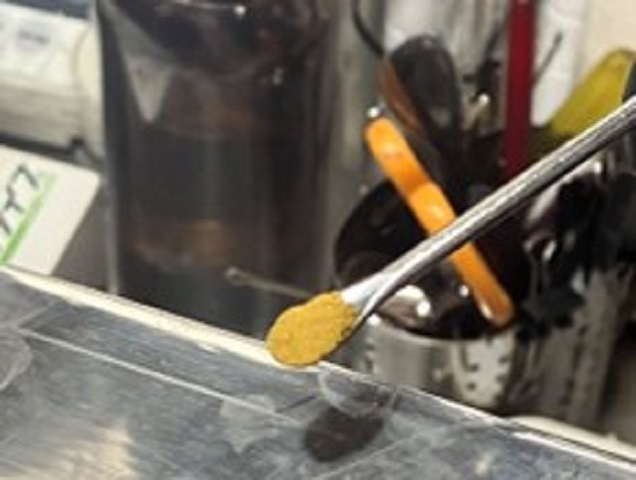Research News
Apr 11, 2024
- Engineering
Discovery brings all-solid-state sodium batteries closer to practical use
Process that can lead to mass synthesis yields solid sulfide electrolyte with world’s highest reported sodium ion conductivity and glass electrolyte with high formability
Synthesized material for all-solid-state sodium batteries
The synthesized solid sulfide electrolyte Na2.88Sb0.88W0.12S4 has the world’s highest reported sodium ion conductivity.
Credit: Atsushi Sakuda, Osaka Metropolitan University

The pursuit of greener energy also requires efficient rechargeable batteries to store that energy. While lithium-ion batteries are currently the most widely used, all-solid-state sodium batteries are attracting attention as sodium is far more plentiful than lithium. This should make sodium batteries less expensive, and solid-state batteries are thought to be safer, but processing issues mean mass production has been difficult.
Osaka Metropolitan University Associate Professor Atsushi Sakuda and Professor Akitoshi Hayashi, both of the Graduate School of Engineering, led a research team in developing a process that can lead to mass synthesis for sodium-containing sulfides.
Using sodium polysulfides (sulfides with two or more atoms of sulfur) as both the material and the flux, which promotes fusion, the team created a solid sulfide electrolyte with the world’s highest reported sodium ion conductivity—about 10 times higher than required for practical use—and a glass electrolyte with high reduction resistance.
Mass synthesis of such electrolytes with high conductivity and formability is key to the practical use of all-solid-state sodium batteries.
“This newly developed process is useful for the production of almost all sodium-containing sulfide materials, including solid electrolytes and electrode active materials,” Professor Sakuda said. “Also, compared to conventional methods, this process makes it easier to obtain materials that display higher performance, so we believe it will become a mainstream process for the future development of materials for all-solid-state sodium batteries.”
The results were published in Energy Storage Materials and Inorganic Chemistry.
Funding
Energy Storage Materials
This work was supported by JSPS KAKENHI Grant Numbers JP20K05688, JP20J23722, JP21H04701, and JP23H02071.
Inorganic Chemistry
This work was supported by JSPS KAKENHI Grant Numbers JP21H04701 and JP23H02071 and the 2023 Osaka Metropolitan University (OMU) Strategic Research Promotion Project (Priority Research).
Paper information #1
Journal: Energy Storage Materials
Title: Utilizing reactive polysulfides flux Na2Sx for the synthesis of sulfide solid electrolytes for all-solid-state sodium batteries
DOI: 10.1016/j.ensm.2024.103307
Authors: Akira Nasu, Tomoya Otono, Takuma Takayanagi, Minako Deguchi, Atsushi Sakuda, Masahiro Tatsumisago, Akitoshi Hayashi
Published: February 27, 2024
URL: https://doi.org/10.1016/j.ensm.2024.103307
Paper information #2
Journal: Inorganic Chemistry
Title: High-Sodium-Concentration Sodium Oxythioborosilicate Glass Synthesized via Ambient Pressure Method with Sodium Polysulfides
DOI: 10.1021/acs.inorgchem.3c04101
Authors: Tomoya Otono, Akira Nasu, Taichi Asakura, Hiroe Kowada, Kota Motohashi, Masahiro Tatsumisago,Atsushi Sakuda, Akitoshi Hayashi
Published: March 1, 2024
URL: https://doi.org/10.1021/acs.inorgchem.3c04101
Contact
Graduate School of Engineering
Email: saku[at]omu.ac.jp
*Please change [at] to @.
SDGs
